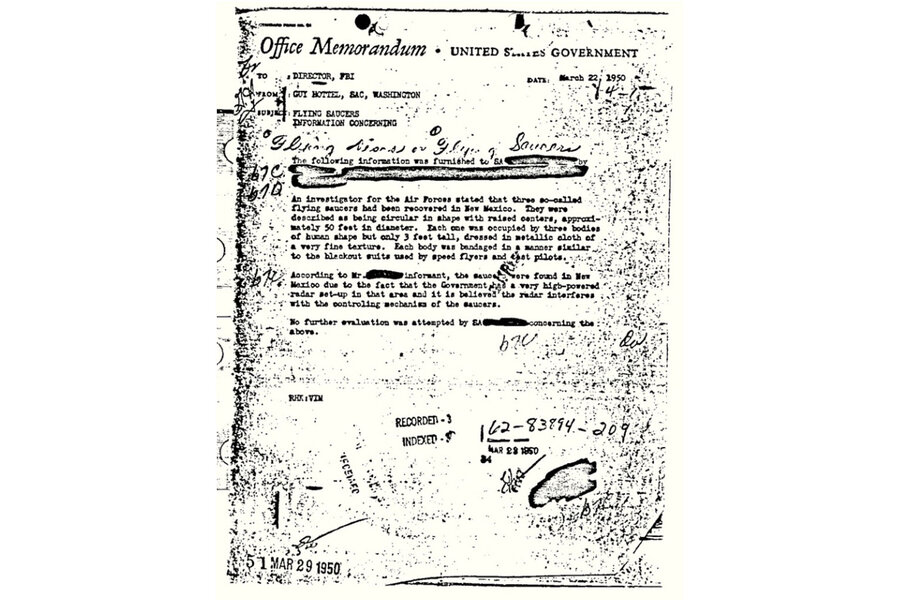Air Force puts declassified UFO reports online. Is the truth out there?
Thanks to the Air Force, more than 130,000 documents describing military investigations of UFO activity over American airspace are now online.
"Project Blue Book" and "Project Grudge" were the official names of the investigations military officials headquartered at Wright-Patterson Air Force Base in Ohio conducted between 1947 and 1969. The projects were discontinued after a joint review determined that no intelligence was being produced from the studies. The report specifically stated that no UFO "reported, investigated and evaluated," ever posed, "any indication of threat to our national security," CNN notes. The investigations suggest that the sightings "represent technological developments or principles beyond the range of present-day scientific knowledge," the network also reported.
The disclosure comes after years of federal Freedom of Information Act requests filed by UFO researcher John Greenewald. The FBI will be making the files available on their website containing case files in PDF form from some of the FBI's most notorious cases, from Bonnie and Clyde to Jimmy Hoffa. According to the same CNN report the case file, the initial field report following an alleged UFO crash at Roswell, New Mexico, in 1947 has garnered over two million page views so far.
Among some of the UFO cases the Project Blue Book Collection touches on are the "Exeter Incident," "the Kenneth Arnold sighting," from 1947 and "the Mantell crash," from 1948.
Here are some of the most high-profile UFO mysteries:
Roswell,1947
During the first week of July in 1947, something is said to have crashed in the New Mexico desert, Northeast of the town of Roswell. Upon learning of the crash site Maj. Jesse Marcel, an intelligence officer for the 509th Bomb Group, who was stationed at Roswell Army Air Field, went to inspect the area. He allegedly found an aluminum foil-thin metal that was indestructible in the debris field, which he claimed composed the outer body of the object. Marcel also claimed that pieces of metal at the site had a strange purple writing on them.
At 11am on July 8, 1947 a public information officer for the base put out a press release stating that wreckage of crashed disk had been recovered. By the end of the day higher-ups in the Air Force made the base commanders release a second press release that asserted the material in the debris field came from a downed weather balloon.
The Exeter Incident, 1965
A man named Norman Muscarello was hitchhiking to his Exeter, N.H. home on a September night when out of no-where, a beam of light that was described as ninety feet in diameter began floating and wobbling towards him. Another panic-stricken woman who was driving from Exeter to Epping, called the police after a similar object had followed her for some 12 miles. The officer on duty did not think much of the woman's call but after Muscarello was picked up by a couple and driven to the police station, the officer wanted to know more.
The officer had Muscarello take him to the spot where he saw the light. Muscarello had originally run to the nearest house to get help and went back to the same residence with the officer. After the owner's horses and dogs began to stir, the beam of light rose above the trees. The police officer had been in the military and failed to recognize what kind of aircraft this was.
After the experience the police officer wrote to the Air Force at Wright-Patterson Air Force Base, but investigators said they could not determine what caused the beam of light.
Kecksburg, Penn, 1965
In a small town 40 miles North of Pittsburgh, residents saw a fiery object crash into the town's woods. Not too long after the object was reported, police and military personnel were on the scene and barricaded off the woods and turned away anyone who tried to get close. Hours later a military flat-bed truck with a large object covered by a tarp was seen leaving the woods, and the authorities never elaborated on what the object was.
A Freedom of Information Act lawsuit filed against NASA to turn over its Kecksburg investigations ended in 2009, according to SPACE.com. As a result, the government did not force NASA to hand over any documents that would explain what became of the object removed from the Pennsylvania woods.






